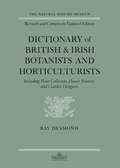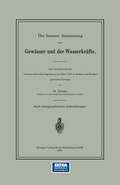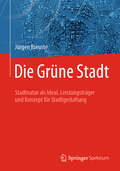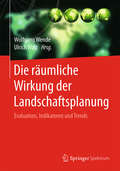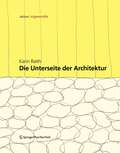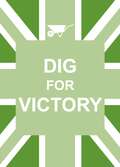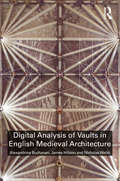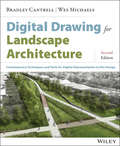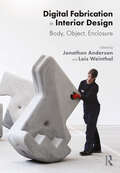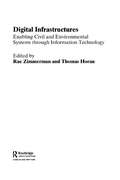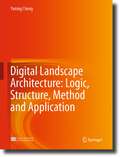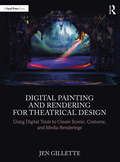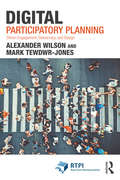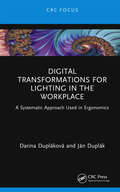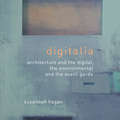- Table View
- List View
Dictionary Of British And Irish Botantists And Horticulturalists Including plant collectors, flower painters and garden designers
by Ray DesmondOver the past four centuries botanists and gardeners in the British Isles have gathered, maintained and propagated many varying species of plants. Their work has been documented in innumerable books and articles which are often difficult to trace. The Dictionary of British and Irish Botanists and Horticulturalists represents a time-saving reference source for those who wish to discover more about the lives and achievements of the horticulturalists listed. The dictionary's utility comes not only from indicating the major publications of the named authors, but also the location of their herbaria and manuscripts.; The previous 1977 edition of the Dictionary has for many years been a much used source of information for botanists, botanic artists and archivists. In this revised edition the scope has been expanded to include among its 13,000 entries flower painters in addition to botanical artists over 1400 entries and, for the first time, garden designers.; Finally the Dictionary should have international appeal since so many botanists and gardeners worked on collective plants overseas, in particular in North America and the British Commonwealth.; Each entry gives, wherever possible, details of dates and places of birth and death, educational qualifications, professional posts, honours and awards, publications, location of plant collections, manuscripts, drawings and portraits. Its main function, however, is to provide further biographical references to books and periodicals. Comprehensive classified indices facilitate access by professions and activities, countries, and plant interests.
Die bessere Ausnutzung der Gewässer und der Wasserkräfte: Auf Veranlassung des Vereines deutscher Ingenieure im Jahre 1888 in Aachen und Breslau gehaltene Vorträge
by O. IntzeDie Grüne Stadt: Stadtnatur als Ideal, Leistungsträger und Konzept für Stadtgestaltung
by Jürgen BreusteDieses Lehrbuch zur Grünen Stadt untersucht Stadtnatur als Ideal, Leistungsträger und Konzept für Stadtgestaltung. Es beantwortet wichtige aktuelle Fragen, die sich zu den ökologischen und kulturellen Grundlagen, zur Entwicklung und Struktur und zum ökologischen Leistungsvermögen von Stadtnatur weltweit stellen. Das Buch erklärt, was Stadtnatur ist, wie sie entstand und wie sie sich im Kontext zu den natürlichen und kulturellen Bedingungen ihrer Standorte entwickelte. Zudem wird beschrieben, was urbane Biodiversität ausmacht und welche Rolle differenzierte Stadtnatur im Konzept der Grünen Stadt einnimmt. Theorien der Stadtentwicklung und Ökologie werden mit praktischen Anwendungen der Stadtplanung verbunden und mit vielen Fallstudien und Beispielen veranschaulicht. Die großen Potenziale von Stadtnatur werden im Detail aufgezeigt. Um Probleme in der Stadt zu bewältigen oder zu mildern, bedarf es eines zielgerichteten, an die besonderen Bedingungen der verschiedenen Stadtnatur-Arten angepassten Stadtnatur-Managements, das Naturschutz wie Naturgestaltung gleichermaßen einschließt und dabei immer den Bezug zu den Stadtbewohnern im Auge behält.Das Lehrbuch spricht besonders Studierende und Lehrende der Fächer Stadtplanung, Ökologie, Geographie, Sozialwissenschaften sowie Praktiker der Stadtgestaltung an.
Die Küche: Lebenswelt, Nutzung, Perspektiven (Living Concepts #1)
by Klaus SpechtenhauserDas Buch erschließt den Lesern die Küche als zentralen Wohnraum des häuslichen Lebens. Die Autorinnen und Autoren untersuchen die Küche – nachdem sie seit den 90er Jahren als modisch-repräsentatives Designobjekt ins Zentrum rückte – in Bezug auf ihre architektonischen, kulturellen, sozialen sowie ökonomischen Bedeutungen. Vorgestellt werden wichtige Entwicklungstendenzen und wegweisende Küchenkonzepte der letzten Jahrzehnte (Frankfurter Küche, Normküchen, Wohnküchen), planerische Grundlagen, aktuellste Trends, die sich wandelnden Bedürfnisse heutiger Benutzer an den Küchenraum (Patchworkfamilien, Singlehaushalte) sowie kulinarische Aspekte. Kurz: Ein Buch, das in keiner Küche des 21. Jahrhunderts fehlen sollte! Unsere neue Buchreihe Edition Wohnen stellt ausgewählte Themen aus dem weiten Feld des Wohnens kurz und übersichtlich vor. Sie richtet sich sowohl an allgemein kulturinteressierte Leserinnen und Leser als auch an Fachleute. Die Reihe wird herausgegeben vom ETH Wohnforum Zürich.
Die räumliche Wirkung der Landschaftsplanung: Evaluation, Indikatoren und Trends
by Wolfgang Wende Ulrich WalzDieses Buch befasst sich mit Leitfragen in der Landschaftsplanung. Aufgabe der Landschaftsplanung ist es, die im Bundesnaturschutzgesetz genannten Ziele des Naturschutzes und der Landschaftspflege in Deutschland umzusetzen. Derzeit erlebt die örtliche Landschaftsplanung eine Renaissance, da die Kommunen mit ihr unter anderem die Auswirkungen der Gewinnung erneuerbarer Energien und der Siedlungsentwicklung auf Natur und Landschaft mildern und steuern wollen. Doch wo genau steht die örtliche Landschaftsplanung in Deutschland heute eigentlich? Rund 75 % der Kommunen besitzen einen Landschaftsplan. Kann die Landschaftsplanung bereits Erfolge vorweisen? Wie war die bisherige Steuerungswirkung eines Landschaftsplans? Wo genau entfalten die Landschaftspläne auch tatsächlich räumliche Wirkung? Diese Leitfragen beschäftigt ein ausgewähltes Autorinnen- und Autorenteam der verschiedensten Forschungseinrichtungen in Deutschland. Sie evaluieren das Planungsinstrument, zeigen neueste Landschaftsindikatoren auf und analysieren Trends der Landschaftsentwicklung und -planung. Das Buch enthält eine Fülle von Abbildungen, Grafiken und Karten, die ebenfalls den Zustand und die Entwicklung von Landschaft in Deutschland dokumentieren.
Die Unterseite der Architektur: Konzepte und Konstruktionen an der Schnittstelle zwischen Kultur und Natur (Edition Angewandte)
by Karin RaithThema und Fragestellungen Dieses Buch handelt von der Beziehung zwischen Bauwerk und Boden. Der Ausgangspunkt der Untersuchung war die Beobachtung, dass Gebäude auf verschiedene Weise auf dem Baugrund ruhen, in ihn eingegraben sind, ihn durchdringen, sich über ihn erheben oder sich von ihm loslösen. Diese unt- schiedlichen Reaktionen auf den Baugrund manifestieren sich auf verschiedenen Maßstabsebenen, sowohl bei der Wahl und architektonischen Interpretation des Standortes eines Gebäudes und in der Ausformung des Baukörpers als auch im konstruk- ven und gestalterischen Detail. Die Architektur wird durch ihre räumlich-volumetrische Form in die geomorphologische Struktur der Landschaft eingeschrieben. Sie kann als eine Anpassung, Ergänzung oder eine Überhöhung, aber auch als Widerpart und Negation des Terrains in Erscheinung treten. Die Architektur tritt über einzelne spezialisierte Elemente mit dem Boden in direkte Verbindung: mit Fundamenten, Sockeln und Stützen, mit Kellergeschoßen, dem Unterbeton, mit Rollierungen, Abdichtungen und Dämmungen. Einige der Bauteile, die dafür verantwortlich sind, die Lasten vom Gebäude auf den Baugrund zu übertragen und Feuchtigkeit und Kälte von seinem Inneren fernzuhalten, erfüllen ihre Aufgaben still und verlässlich in der Tiefe des Baugrundes. Sie sind, sobald der Bauvorgang abgeschlossen ist, nicht mehr zu sehen. Sie haben konstruktiv einiges zu leisten, darüber hinaus aber nichts mitzuteilen oder darzustellen. Viel interessanter sind hingegen die Bauteile in der Zone, wo Architektur und Erdoberfläche sichtbar aufeinandertreffen. Der spannendste Topos der Konfrontation von Bau und Boden 11 sind die reale oder imaginäre Schnittlinie der Gebäudeoberfläche mit dem Gelände und das Kraftfeld, das diese Linieumgibt.
Dig For Victory
by Summersdale PublishersThe World War Two slogan is still pertinent in these thrifty times as more people than ever are turning to self-sufficiency and growing their own fruit and vegetables. This little compendium is packed with tips and hints on how to make the most of your garden along with witty quotations to help you dig for victory.
Digital Analysis of Vaults in English Medieval Architecture
by Alexandrina Buchanan James Hillson Nicholas WebbMedieval churches are one of the most remarkable creative and technical achievements in architectural history. The complex vaults spanning their vast interiors have fascinated both visitors and worshippers alike for over 900 years, prompting many to ask: ‘How did they do that?’ Yet very few original texts or drawings survive to explain the processes behind their design or construction. This book presents a ground-breaking new approach for analysing medieval vaulting using advanced digital technologies. Focusing on the intricately patterned rib vaulting of thirteenth and fourteenth century England, the authors re-examine a series of key sites within the history of Romanesque and Gothic Architecture, using extensive digital surveys to examine the geometries of the vaults and provide new insights into the design and construction practices of medieval masons. From the simple surfaces of eleventh-century groin vaults to the gravity-defying pendant vaults of the sixteenth century, they explore a wide range of questions including: How were medieval vaults conceived and constructed? How were ideas transferred between sites? What factors led to innovations? How can digital methods be used to enhance our understanding of medieval architectural design? Featuring over 200 high quality illustrations that bring the material and the methods used to life, Digital Analysis of Vaults in English Medieval Architecture is ideal reading for students, researchers and anyone with an interest in medieval architecture, construction history, architectural history and design, medieval geometry or digital heritage.
Digital Analysis of Vaults in English Medieval Architecture
by Alexandrina Buchanan James Hillson Nicholas WebbMedieval churches are one of the most remarkable creative and technical achievements in architectural history. The complex vaults spanning their vast interiors have fascinated both visitors and worshippers alike for over 900 years, prompting many to ask: ‘How did they do that?’ Yet very few original texts or drawings survive to explain the processes behind their design or construction. This book presents a ground-breaking new approach for analysing medieval vaulting using advanced digital technologies. Focusing on the intricately patterned rib vaulting of thirteenth and fourteenth century England, the authors re-examine a series of key sites within the history of Romanesque and Gothic Architecture, using extensive digital surveys to examine the geometries of the vaults and provide new insights into the design and construction practices of medieval masons. From the simple surfaces of eleventh-century groin vaults to the gravity-defying pendant vaults of the sixteenth century, they explore a wide range of questions including: How were medieval vaults conceived and constructed? How were ideas transferred between sites? What factors led to innovations? How can digital methods be used to enhance our understanding of medieval architectural design? Featuring over 200 high quality illustrations that bring the material and the methods used to life, Digital Analysis of Vaults in English Medieval Architecture is ideal reading for students, researchers and anyone with an interest in medieval architecture, construction history, architectural history and design, medieval geometry or digital heritage.
Digital Drawing for Landscape Architecture: Contemporary Techniques and Tools for Digital Representation in Site Design
by Bradley Cantrell Wes MichaelsCombine traditional techniques with modern media for more communicative renderings Digital Drawing for Landscape Architecture: Contemporary Techniques and Tools for Digital Representation in Site Design, Second Edition bridges the gap between traditional analog and new digital tools by applying timeless concepts of representation to enhance design work in digital media. The book explores specific techniques for creating landscape designs, including digitally rendered plans, perspectives, and diagrams, and the updated second edition offers expanded coverage of newer concepts and techniques. Readers will gain insight into the roles of different drawings, with a clear emphasis on presenting a solid understanding of how diagram, plan, section, elevation, and perspective work together to present a comprehensive design approach. Digital rendering is faster, more efficient, and more flexible than traditional rendering techniques, but the design principles and elements involved are still grounded in hand-rendering techniques. Digital Drawing for Landscape Architecture exploits both modalities to help designers create more beautiful, accurate, and communicative drawings in a professional studio environment. This second edition contains revised information on plan rendering techniques, camera matching workflow, and color selection, along with brand new features, like: Time-based imagery and tools Workflow integration techniques Photoshop and Illustrator task automation Over 400 updated images, plus over 50 new examples of award-winning work The book takes a tutorial-based approach to digital rendering, allowing readers to start practicing immediately and get up to speed quickly. Communication is a vital, but often overlooked component of the design process, and designers rely upon their drawings to translate concepts from idea to plan. Digital Drawing for Landscape Architecture provides the guidance landscape designers need to create their most communicative renderings yet.
Digital Drawing for Landscape Architecture: Contemporary Techniques and Tools for Digital Representation in Site Design
by Bradley Cantrell Wes MichaelsCombine traditional techniques with modern media for more communicative renderings Digital Drawing for Landscape Architecture: Contemporary Techniques and Tools for Digital Representation in Site Design, Second Edition bridges the gap between traditional analog and new digital tools by applying timeless concepts of representation to enhance design work in digital media. The book explores specific techniques for creating landscape designs, including digitally rendered plans, perspectives, and diagrams, and the updated second edition offers expanded coverage of newer concepts and techniques. Readers will gain insight into the roles of different drawings, with a clear emphasis on presenting a solid understanding of how diagram, plan, section, elevation, and perspective work together to present a comprehensive design approach. Digital rendering is faster, more efficient, and more flexible than traditional rendering techniques, but the design principles and elements involved are still grounded in hand-rendering techniques. Digital Drawing for Landscape Architecture exploits both modalities to help designers create more beautiful, accurate, and communicative drawings in a professional studio environment. This second edition contains revised information on plan rendering techniques, camera matching workflow, and color selection, along with brand new features, like: Time-based imagery and tools Workflow integration techniques Photoshop and Illustrator task automation Over 400 updated images, plus over 50 new examples of award-winning work The book takes a tutorial-based approach to digital rendering, allowing readers to start practicing immediately and get up to speed quickly. Communication is a vital, but often overlooked component of the design process, and designers rely upon their drawings to translate concepts from idea to plan. Digital Drawing for Landscape Architecture provides the guidance landscape designers need to create their most communicative renderings yet.
Digital Fabrication in Interior Design: Body, Object, Enclosure
by Jonathon Anderson Lois WeinthalDigital Fabrication in Interior Design: Body, Object, Enclosure draws together emerging topics of making that span primary forms of craftsmanship to digital fabrication in order to theoretically and practically analyze the innovative and interdisciplinary relationship between digital fabrication technology and interior design. The history of making in interior design is aligned with traditional crafts, but a parallel discourse with digital fabrication has yet to be made evident. This book repositions the praxis of experimental prototyping and integrated technology to show how the use of digital fabrication is inherent to the interior scales of body, objects and enclosure. These three scales act as a central theme to frame contributions that reinforce the interdisciplinary nature of interior design and reinterpret traditional crafts by integrating new methods of making into conventional workflows. Featuring significant international practitioners and researchers, the selected contributions represent the ever-increasing interdisciplinary nature of design, demonstrating a breadth of disciplines. A foundational text for interiors students and practitioners, Digital Fabrication in Interior Design expands the necessary dialogue about digital fabrication at the scale of interiors to inform design theory and practice.
Digital Fabrication in Interior Design: Body, Object, Enclosure
by Jonathon Anderson Lois WeinthalDigital Fabrication in Interior Design: Body, Object, Enclosure draws together emerging topics of making that span primary forms of craftsmanship to digital fabrication in order to theoretically and practically analyze the innovative and interdisciplinary relationship between digital fabrication technology and interior design. The history of making in interior design is aligned with traditional crafts, but a parallel discourse with digital fabrication has yet to be made evident. This book repositions the praxis of experimental prototyping and integrated technology to show how the use of digital fabrication is inherent to the interior scales of body, objects and enclosure. These three scales act as a central theme to frame contributions that reinforce the interdisciplinary nature of interior design and reinterpret traditional crafts by integrating new methods of making into conventional workflows. Featuring significant international practitioners and researchers, the selected contributions represent the ever-increasing interdisciplinary nature of design, demonstrating a breadth of disciplines. A foundational text for interiors students and practitioners, Digital Fabrication in Interior Design expands the necessary dialogue about digital fabrication at the scale of interiors to inform design theory and practice.
Digital Infrastructures: Enabling Civil and Environmental Systems through Information Technology (Networked Cities Series)
by Thomas Horan Rae ZimmermanAn invisible network of digital technology systems underlies the highly visible networks of roads, waterways, satellites, and power-lines. Increasingly, these systems are becoming the "infrastructure's infrastructure," providing a crucial array of data on network demand, performance, reliability, and security. Digital Infrastructures presents an interdisciplinary analysis of the technological systems that envelop these networks. The book balances analyses of specific civil and environmental infrastructures with broader policy and management issues, including the challenges of using IT to manage these critical systems under crises conditions.
Digital Infrastructures: Enabling Civil and Environmental Systems through Information Technology (Networked Cities Series)
by Rae Zimmerman Thomas HoranAn invisible network of digital technology systems underlies the highly visible networks of roads, waterways, satellites, and power-lines. Increasingly, these systems are becoming the "infrastructure's infrastructure," providing a crucial array of data on network demand, performance, reliability, and security. Digital Infrastructures presents an interdisciplinary analysis of the technological systems that envelop these networks. The book balances analyses of specific civil and environmental infrastructures with broader policy and management issues, including the challenges of using IT to manage these critical systems under crises conditions.
Digital Landscape Architecture: Logic, Structure, Method and Application
by Yuning ChengClosely related to the frontier research field of “digital technology”, this book reshapes the planning and design process of landscape architecture from theoretical and practical levels. It gives a full-scale discussion to the logic, structure, method, and application of digital landscape architecture, leading this field to a new era of perception-quantification research mode. Readers will get a comprehensive understanding of digital landscape architecture, know about multiple digital methods for landscape planning and design, and learn a lot of practical projects with digital technology. And it will inspire the readers to think about new patterns and approaches to landscape planning, rather than traditional ways. This book is organized under a clear logic, which helps the readers easily get the core of the work. A lot of logic diagrams showing between the theoretical paragraphs highly summarize the key points of the book, providing a better readability and acceptability. This book also contains many detailed drawings and graphics for the project cases, which gives a good demonstration of how digital methods could be applied in practice.
Digital Painting and Rendering for Theatrical Design: Using Digital Tools to Create Scenic, Costume, and Media Renderings
by Jen GilletteDigital Painting and Rendering for Theatrical Design explores the tools and techniques for creating dazzling, atmospheric, and evocative digitally painted renderings for scenic, costume, and projection/integrated media design. By focusing on technique rather than the structure of a particular software, this book trains theatrical designers to think and paint digitally, regardless of the software or hardware they choose. The text begins with the construction of the artist’s physical and digital workspace, then delves into an explanation of tool functionality, technique-building exercises, and examples from professional theatrical designers to help contextualize the concepts presented. Each chapter gradually progresses in complexity through skill-building exercises and advanced tool functionality, covering concepts like brush construction, various forms of masking, and layer interaction. The book explores various methods of constructing a digital rendering, including producing digital paintings that look like traditional media and photo bashing – the practice of using extant photographs to create a collaged image. Concepts are contextualized throughout the text using illustrations, quotes, and interviews with working professional designers. This beautifully illustrated guide is written for professional theatrical artists, students of theatrical design, and other visual artists looking to broaden their digital painting skillset.
Digital Painting and Rendering for Theatrical Design: Using Digital Tools to Create Scenic, Costume, and Media Renderings
by Jen GilletteDigital Painting and Rendering for Theatrical Design explores the tools and techniques for creating dazzling, atmospheric, and evocative digitally painted renderings for scenic, costume, and projection/integrated media design. By focusing on technique rather than the structure of a particular software, this book trains theatrical designers to think and paint digitally, regardless of the software or hardware they choose. The text begins with the construction of the artist’s physical and digital workspace, then delves into an explanation of tool functionality, technique-building exercises, and examples from professional theatrical designers to help contextualize the concepts presented. Each chapter gradually progresses in complexity through skill-building exercises and advanced tool functionality, covering concepts like brush construction, various forms of masking, and layer interaction. The book explores various methods of constructing a digital rendering, including producing digital paintings that look like traditional media and photo bashing – the practice of using extant photographs to create a collaged image. Concepts are contextualized throughout the text using illustrations, quotes, and interviews with working professional designers. This beautifully illustrated guide is written for professional theatrical artists, students of theatrical design, and other visual artists looking to broaden their digital painting skillset.
Digital Participatory Planning: Citizen Engagement, Democracy, and Design (RTPI Library Series)
by Alexander Wilson Mark Tewdwr-JonesDigital Participatory Planning outlines developments in the field of digital planning and designs and trials a range of technologies, from the use of apps and digital gaming through to social media, to examine how accessible and effective these new methods are. It critically discusses urban planning, democracy, and computing technology literature, and sets out case studies on design and deployment. It assesses whether digital technology offers an opportunity for the public to engage with urban change, to enhance public understanding and the quality of citizen participation, and to improve the proactive possibilities of urban planning more generally. The authors present an exciting alternative story of citizen engagement in urban planning through the reimagination of participation that will be of interest to students, researchers, and professionals engaged with a digital future for people and planning.
Digital Participatory Planning: Citizen Engagement, Democracy, and Design (RTPI Library Series)
by Alexander Wilson Mark Tewdwr-JonesDigital Participatory Planning outlines developments in the field of digital planning and designs and trials a range of technologies, from the use of apps and digital gaming through to social media, to examine how accessible and effective these new methods are. It critically discusses urban planning, democracy, and computing technology literature, and sets out case studies on design and deployment. It assesses whether digital technology offers an opportunity for the public to engage with urban change, to enhance public understanding and the quality of citizen participation, and to improve the proactive possibilities of urban planning more generally. The authors present an exciting alternative story of citizen engagement in urban planning through the reimagination of participation that will be of interest to students, researchers, and professionals engaged with a digital future for people and planning.
Digital Transformations for Lighting in the Workplace: A Systematic Approach Used in Ergonomics
by Darina Dupláková Ján DuplákDigital Transformations for Lighting in the Workplace: A Systematic Approach Used in Ergonomics offers a practical concept for the implementation of digital transformation in ergonomics in work settings. It specifically focuses on providing information about illumination in production and non-production fields, and the described design solutions are applicable in practice. The concepts can be used in a typical manufacturing workplace or an academic setting. The methods in the book complement the modern trend to digitalise the workplace, making the research and practical outcomes of this book compatible with the concept of Industry 4.0 - Digital Manufacturing. This title offers a systematic approach to the field of digital transformation for ergonomics. It presents an opportunity for the reader to learn to create a digital model for lighting by analysing mathematical models for calculation through formulas and simulation algorithms. To put learning into context, this book provides two case studies from the production and non-production sectors, including an example of a classroom. The reader will then be able to utilise the methods to create their own digitized illumination system. This monograph is an ideal read for academics and researchers working at universities in the field of Ergonomics and professionals in industrial management including those in manufacturing plants, ergonomists, designers from the industry sector, or people who are interested in ergonomics, digitization, and simulation of a working environment.
Digital Transformations for Lighting in the Workplace: A Systematic Approach Used in Ergonomics
by Darina Dupláková Ján DuplákDigital Transformations for Lighting in the Workplace: A Systematic Approach Used in Ergonomics offers a practical concept for the implementation of digital transformation in ergonomics in work settings. It specifically focuses on providing information about illumination in production and non-production fields, and the described design solutions are applicable in practice. The concepts can be used in a typical manufacturing workplace or an academic setting. The methods in the book complement the modern trend to digitalise the workplace, making the research and practical outcomes of this book compatible with the concept of Industry 4.0 - Digital Manufacturing. This title offers a systematic approach to the field of digital transformation for ergonomics. It presents an opportunity for the reader to learn to create a digital model for lighting by analysing mathematical models for calculation through formulas and simulation algorithms. To put learning into context, this book provides two case studies from the production and non-production sectors, including an example of a classroom. The reader will then be able to utilise the methods to create their own digitized illumination system. This monograph is an ideal read for academics and researchers working at universities in the field of Ergonomics and professionals in industrial management including those in manufacturing plants, ergonomists, designers from the industry sector, or people who are interested in ergonomics, digitization, and simulation of a working environment.
Digitalia: Architecture and the Digital, the Environmental and the Avant-Garde
by Susannah HaganSusannah Hagan boldly discusses the fraught relationship between key dominating areas of architectural discourse - digital design, environmental design, and avant-garde design.Digitalia firstly demonstrates that drawing such firm lines between architectural spheres is damaging and foolish, particularly as both environmental and avant-garde practices are experimenting with the digital, and secondly remonstrates with an avant-garde that has repudiated the social/ethical agenda of the modernist avant-garde because it failed the first time round. It is environmental architecture that has picked up the social/ethical ball and is running with it, using the digital to very different, and more far-reaching, ends.As the debates rage, this book is a key read for all who are involved or intrigued.
Digitalia: Architecture and the Digital, the Environmental and the Avant-Garde
by Susannah HaganSusannah Hagan boldly discusses the fraught relationship between key dominating areas of architectural discourse - digital design, environmental design, and avant-garde design.Digitalia firstly demonstrates that drawing such firm lines between architectural spheres is damaging and foolish, particularly as both environmental and avant-garde practices are experimenting with the digital, and secondly remonstrates with an avant-garde that has repudiated the social/ethical agenda of the modernist avant-garde because it failed the first time round. It is environmental architecture that has picked up the social/ethical ball and is running with it, using the digital to very different, and more far-reaching, ends.As the debates rage, this book is a key read for all who are involved or intrigued.
